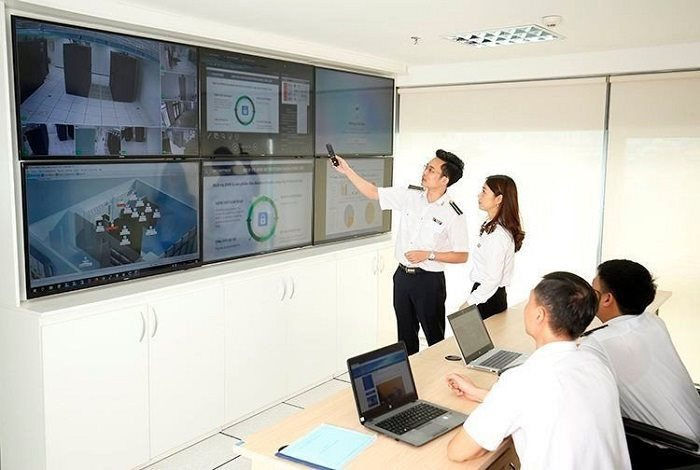(sav.gov.vn) – Against the background that audited entities have conducted comprehensive and profound digital transformation in their management, operations, and delivery of public services, the State Audit Office of Viet Nam (SAV) is also undergoing a “transformation course”, making efforts to digitalise and apply new technologies in its audit activities.

Data infrastructure – the foundation for digitalising audit operations
In reality, digital transformation is reshaping management and leadership approaches, work processes, and has become a major trend applied widely across economic, social, and daily life sectors. For instance, in the banking sector, Mr. Pham Anh Tuan, Director of the Payment Department of the State Bank of Viet Nam, stated that digital technology has been thoroughly applied throughout the entire system of credit institutions to meet market demands and international integration. “Banks and payment intermediaries are interconnected via a centralised, modern digital payment infrastructure that processes transactions within seconds,” said Mr. Tuan.
The shift in operation and management methods by agencies and organisations has placed increasing demands on the SAV to continuously innovate, particularly by strengthening the application of technology in audit activities. Recognising this, in recent times, the SAV has focused on developing audit procedures and regulations related to information technology (IT) management to update, store, and utilise digital data in support of audit work. It has also been implementing the construction of a shared database system and a platform system to facilitate data connectivity and sharing with audited entities and relevant authorities.
In this context, the digitalisation of audit documentation is essential to align with the digital transformation trend and to build a centralised data warehouse for the SAV. According to Mr. Nguyen Van Quang, Deputy Director of the IT Department, the SAV has basically completed the digitalisation of audit reports and documentation from its 2024 audits.
The IT Department is currently coordinating with audit units to explore solutions for organising, analysing, and processing data in support of a pilot application of artificial intelligence (AI) in synthesising audit experience and assisting auditors in formulating audit recommendations and selecting entities for audit planning. This includes areas such as enterprise audits and local government budget audits.
As one of the units effectively implementing digitalisation of audit records, the Regional Audit Office No. V reported that immediately after an audit report is issued, its synthesis team promptly proceeds with digitalisation steps such as printing and attaching barcodes to audit files. The unit also updates audit results and follow-up outcomes on recommendations into the sector's software system in a timely manner. “Digitalisation has significantly contributed to improving the management of audit records and facilitated easier data retrieval for audit purposes,” the unit’s leadership stated.
Alongside establishing digital infrastructure, the SAV has also enhanced its data connectivity and sharing with audited entities via the SAV’s Information Exchange Portal and through collaboration with other agencies and organisations. This has brought practical benefits and efficiency to audit work, which would be difficult to achieve using traditional, manual methods. For example, the SAV and Viet Nam Social Security (VSS) have signed a coordination regulation on information exchange between the two entities. According to VSS leadership, timely access to information has enabled the SAV to help prevent evasion of contributions, fraud, and misuse of social and health insurance policies. Meanwhile, according to SAV’s Specialised Audit Department No. VII, the data provided has enabled the SAV to quickly identify key risks when auditing the entities having connection to the VSS system.
Piloting the application of AI in audit activities
Currently, auditing units are actively implementing audits according to the 2025 annual plan. In this process, digital data utilisation and new technology applications in audit activities are receiving increasing attention from the SAV, yielding positive initial outcomes that facilitate operations and reduce workloads for auditors.
The application of AI in audit activities will be piloted by the SAV before being scaled up across audit areas. Based on audit practice and international experience, auditors from SAV’s Specialised Audit Department No. VII believe that AI can be applied in various stages of the audit process, such as performing journal entry testing by identifying unusual transactions within large volumes of unstructured data and analysing those transactions to detect patterns and anomalies.
Adding to this perspective from the enterprise side in the auditing sector, a representative from the professional team at PwC Viet Nam shared that during the planning and risk assessment stages, auditors can use AI to help identify key risks related to a particular process or scope, either at the global or sectoral level. AI can also assist auditors in designing appropriate work programmes to support PwC's audit procedures. “This significantly reduces the time needed for researching and designing audit work programmes,” the PwC representative noted.
It can be said that digitalisation and IT application have become imperative in audit activities. Practice also shows that there is significant potential and promising prospects for applying AI in the SAV’s audit work. However, many experts stress that applying technology in general and AI in particular to audit activities must be approached with caution to mitigate risks. Importantly, it should be viewed as a supportive tool that cannot replace the professional judgement and accountability of auditors. A clear understanding of this will help avoid underestimating IT applications in audit work while also preventing overreliance on technology, which may lead to regrettable errors in audit assessments and results, ultimately affecting the SAV’s credibility.